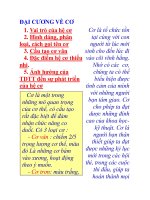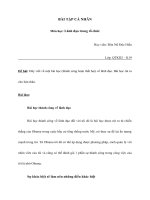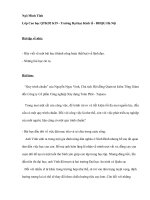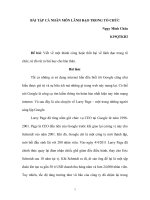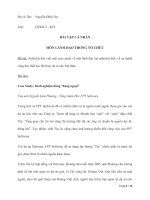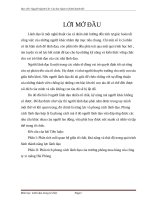Slide đại cương về lãnh đạo trong tổ chức influencing power, politics, networking and negotiation
Bạn đang xem bản rút gọn của tài liệu. Xem và tải ngay bản đầy đủ của tài liệu tại đây (27.06 MB, 43 trang )
LEADERSHIP:
.c
om
Theory, Application, Skill Development
ng
2d Edition
ng
th
an
co
Robert N. Lussier
and Christopher
F. Achua
.
du
o
This presentation edited and enhanced by:
u
George W. Crawford
cu
Asst. Prof. of Mgmt.
Clayton College & State University
Morrow, GA 30260
Copyright ©2004 by South-Western, a division of Thomson Learning. All rights reserved.
CuuDuongThanCong.com
4-1
/>
.c
om
Chapter 4
cu
u
du
o
ng
th
an
co
ng
Influencing: Power,
Politics,
Networking and
Negotiation
Copyright ©2004 by South-Western, a division of Thomson Learning. All rights reserved.
CuuDuongThanCong.com
4-2
/>
.c
om
Chapter 4
Learning Outcomes
cu
u
du
o
ng
th
an
co
ng
• Position vs personal power
• Differences among legitimate, reward,
coercive, and referent power
• Relationship of power and politics
• Similar use of money and politics
• Steps in networking process
• Steps in negotiation process
• Relationship among: negotiation, conflict,
influencing tactics, power, politics
Copyright ©2004 by South-Western, a division of Thomson Learning. All rights reserved.
CuuDuongThanCong.com
4-3
/>
ng
co
an
cu
u
du
o
ng
th
The process
of affecting
others’
attitudes
and behavior
to achieve
an objective.
.c
om
Influencing
Copyright ©2004 by South-Western, a division of Thomson Learning. All rights reserved.
CuuDuongThanCong.com
4-4
/>
ng
.c
om
2 Sources of Power
du
o
ng
th
an
co
Position
Derived from
top management
cu
u
Personal
Derived from the
follower based
on leader’s behavior
Copyright ©2004 by South-Western, a division of Thomson Learning. All rights reserved.
CuuDuongThanCong.com
4-5
/>
Rational
Persuasion
.c
om
Inspirational
Appeals
Pressure
th
an
co
ng
9
Influencing
Tactics
Consultation
du
o
ng
Legitimization
cu
u
Coalitions
Exchange
Ingratiation
Personal
Appeals
Copyright ©2004 by South-Western, a division of Thomson Learning. All rights reserved.
4-6
Source: Adapted from J. French and B.H. Raven. 1959. “The Bases of Social Power.” In Studies of Social Power. D. Cartwright, ed. Ann Arbor, MI: Institute for Social
CuuDuongThanCong.com
/>
• Legal/Legitimate:
.c
om
Types of Power
co
ng
– Comes from appointed/elected position
– Most followers grant this to a leader
an
• Reward:
cu
u
du
o
ng
th
– Control of things valued by followers
– Based on exchange relationship
Copyright ©2004 by South-Western, a division of Thomson Learning. All rights reserved.
CuuDuongThanCong.com
4-7
/>
Types of Power
Referent:
cu
u
du
o
ng
th
an
co
ng
.c
om
– Based on respect & personal relationships
• Earned respect increases referent power
• Being better liked increases referent power
• Being seen as a team player, dedicated,
and effective increase referent power
– Can be developed by anyone regardless of
other types of power or the lack thereof
– Critical between:
• Leaders & followers
• Peers
• Leaders & their superiors
– Excellent base for a relational or balanced
relational/structural leadership style
Copyright ©2004 by South-Western, a division of Thomson Learning. All rights reserved.
CuuDuongThanCong.com
4-8
/>
Types of Power
• Expert:
an
co
ng
.c
om
– Comes from skill, expertise, knowledge
– Makes others dependent on the person
with the power
– Can be for advice, to fix your
computer, etc.
th
• Information/Resource:
u
$$$
Equipment
Human Resources
Supplies & Material
cu
•
•
•
•
du
o
ng
– Comes from control of data, information
or other needed resources
Copyright ©2004 by South-Western, a division of Thomson Learning. All rights reserved.
CuuDuongThanCong.com
4-9
/>
Types of Power
• Coercive/Punishment:
.c
om
– Ability to punish or withhold rewards
– Often used by peers to enforce norms
co
ng
• Connection:
cu
u
du
o
ng
th
an
– Comes from associating with influential
people
– Political
Copyright ©2004 by South-Western, a division of Thomson Learning. All rights reserved.
CuuDuongThanCong.com
4-10
/>
.c
om
THE SINGLE MOST EFFECTIVE
WAY TO ACCUMULATE POWER
IN AN ORGANIZATION
cu
u
du
o
ng
th
an
co
ng
Regularly provide services,
favors, and assistance to
everyone within the
organization. The more
impossible these acts are to
repay, the greater
the power gain.
Copyright ©2004 by South-Western, a division of Thomson Learning. All rights reserved.
CuuDuongThanCong.com
4-11
/>
ng
co
an
cu
u
du
o
ng
th
• The process
of gaining and
using power
• Fact of life in
organizations
• Neither good
or bad
.c
om
Politics
Copyright ©2004 by South-Western, a division of Thomson Learning. All rights reserved.
CuuDuongThanCong.com
4-12
/>
.c
om
ng
co
an
th
Reciprocity
cu
u
du
o
ng
3
Common
Political
Behaviors
Networking
Coalitions
Copyright ©2004 by South-Western, a division of Thomson Learning. All rights reserved.
CuuDuongThanCong.com
4-13
/>
Learn the Organizational
Culture & Power Players
Coalitions
co
ng
Reciprocity
.c
om
Political Behavior Skill
Development
th
an
Develop Good Working Relationships
Especially with your Manager
du
o
ng
Be Loyal, Honest Team Player
cu
u
Gain Recognition
Networking
Copyright ©2004 by South-Western, a division of Thomson Learning. All rights reserved.
CuuDuongThanCong.com
4-14
/>
Networking on the Job
u
du
o
ng
th
an
co
ng
.c
om
• Key to promotion to
higher management
• Requires social skills
• Is about building
professional relationships
and friendships
• Difficult for women
cu
– Not called “the good old boy
network” for nothing
Copyright ©2004 by South-Western, a division of Thomson Learning. All rights reserved.
CuuDuongThanCong.com
4-15
/>
.c
om
Networking to Find a Job
co
ng
• Most successful approach
• 2/3 of all jobs
ng
th
an
– Word of mouth
– Informal referrals
cu
u
du
o
• Results in more new jobs
than all other methods
combined
Copyright ©2004 by South-Western, a division of Thomson Learning. All rights reserved.
CuuDuongThanCong.com
4-16
/>
.c
om
The Networking Process
cu
u
du
o
ng
th
an
co
ng
• Perform a self-assessment and
set goals
• Create your one-minute self sell
• Develop your network
• Conduct networking interviews
• Maintain your network
Copyright ©2004 by South-Western, a division of Thomson Learning. All rights reserved.
CuuDuongThanCong.com
4-17
/>
ng
.c
om
Perform a Self-Assessment
and Set Goals
cu
u
du
o
ng
th
an
co
• Accomplishments
• Tie accomplishments to the
Job Interview
ã Set Networking Goals
Copyright â2004 by South-Western, a division of Thomson Learning. All rights reserved.
CuuDuongThanCong.com
4-18
/>
.c
om
Create Your
One-Minute Self-Sell
cu
u
du
o
ng
th
an
co
ng
• History of your career
• Plans for the future
ã Questions to stimulate
conversation
ã Write and Practice
Copyright â2004 by South-Western, a division of Thomson Learning. All rights reserved.
CuuDuongThanCong.com
4-19
/>
.c
om
Develop Your Network
an
co
ng
• Begin with who you know
• Expand to people you don’t
know
du
o
ng
th
– Referrals
– Volunteer work
cu
u
• Develop ability to remember
peoples’ names
Copyright ©2004 by South-Western, a division of Thomson Learning. All rights reserved.
CuuDuongThanCong.com
4-20
/>
.c
om
Conduct
Networking Interviews
cu
u
du
o
ng
th
an
co
ng
• Not job interviews
• Use network list
• Use many interviews to
reach networking goals
• Informal or via telephone
• You are the interviewer
– Be prepared
Copyright ©2004 by South-Western, a division of Thomson Learning. All rights reserved.
CuuDuongThanCong.com
4-21
/>
Conducting Interviews
cu
u
du
o
ng
th
an
co
ng
.c
om
• Establish rapport
• Deliver your one-minute selfsell
• Ask prepared questions
• Get additional contacts for your
network
• Ask your contacts how you
might help them
• Followup
– Send thank-you notes
– Give status reports
Copyright ©2004 by South-Western, a division of Thomson Learning. All rights reserved.
CuuDuongThanCong.com
4-22
/>
.c
om
NEGOTIATION
du
o
ng
th
an
co
ng
• Two or more parties which
are in conflict (disagreement)
working to reach an
agreement
ã Common in:
cu
u
Job searches
Labor relations
Sales
Copyright â2004 by South-Western, a division of Thomson Learning. All rights reserved.
CuuDuongThanCong.com
4-23
/>
.c
om
Negotiation Process
Agreement
ng
Plan
co
No
Agreement
cu
u
du
o
ng
th
an
Negotiations
Postponement
Close the
deal
Copyright ©2004 by South-Western, a division of Thomson Learning. All rights reserved.
CuuDuongThanCong.com
4-24
/>
PLAN
.c
om
• Research the other party(ies)
• Set objectives
th
an
co
ng
– Lower limit
– Objective
– Opening
cu
u
du
o
ng
• Develop options & tradeoffs
• Be prepared to deal with
questions & objections
(especially unstated)
Copyright ©2004 by South-Western, a division of Thomson Learning. All rights reserved.
CuuDuongThanCong.com
4-25
/>
